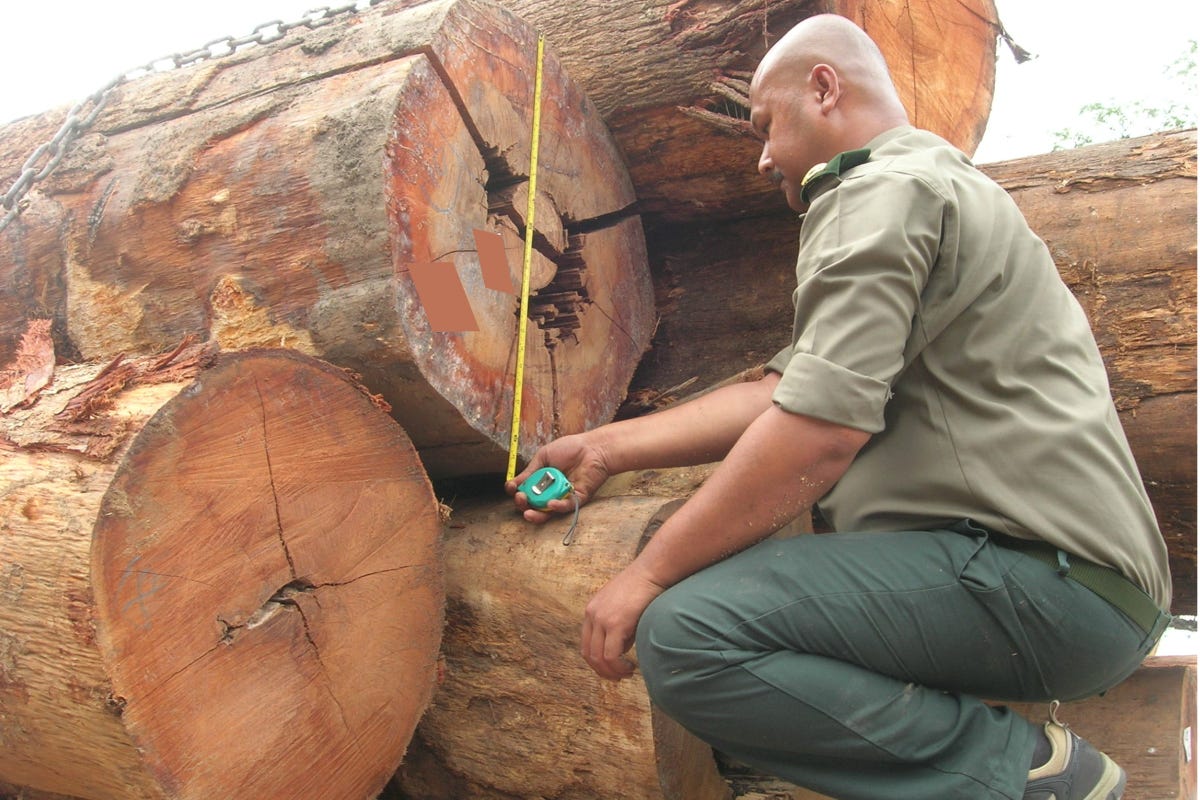Field Clicks: The Checking Station
The power of simple measurements to ensure sustainability or vulnerability
Field Clicks is a new series that uses images from the field to demonstrate key insights into conservation and natural resource management issues.
Imagine saving the rainforest with a measuring tape. It happens.
The road to sustainability is long, bumpy and hazardous. It is a daily grind. It is a constant struggle between economic forces - good and bad - and legal enforcement - good and bad.
Vertical trees exit tropical forests as horizontal logs laid atop one another on dusty logging lorries. Each roundish log takes a journey out of the ecosystem to end up across the globe as a flat timber plank in a lumberyard or as a window frame at Home Depot.
But before these logs even reach the sawmill, they must stop at the checking station - a critical component not always listed on the sustainable checklist. These remote checkpoints are the first layer of protection for ensuring well-managed forests. But they are also far enough away from prying eyes for those who want to game the system.
First, understand the pathway from timber tree to wood product. Trees are harvested and cut into logs. A plastic tag number is stapled to each log that also corresponds to the number on the remaining stump. All of these tags are recorded and traceable. Logging trucks are only allowed to haul out the logs loaded and listed on their delivery order sheets.
These logs reach the sawmill with proper paperwork, where millers make various sawn timber lengths that are sold to wood exporter companies. Timber products eventually arrive in Japan, Europe and the United States to be sold to consumers as planks, boards, frames, doors and flooring.
The paper trail is the key. No paperwork, no transport, no payment. For sustainable products, the end product sold overseas can be traced to the forest of origin down to the tree stump.
Next stop. The checking station. Forest lands in Malaysia are mostly under government, federal and state, control. Thus, forest officials and rangers work the checking stations, which are usually temporary shelters located closer to active logging areas.
Why is a checking station so important? It’s where accountability really starts. It’s also where the shenanigans can start. It’s the point where what comes out of the forest is supposed to jive with what goes out. It’s also where the money enters the equation. Let’s review the negative side of non-sustainability and the manipulation of the timber extraction system.
Every logging truck carries an exit pass from the authorities that lists the loaded logs, which might include preliminary log measurements. When the trucks roll up to the checking station, rangers are responsible for taking the official measurements - usually circumference, diameter and length. These numbers are officially recorded in log books and used to determine both the wood volume leaving the forest and the amount of cess (fee) charged to the logging company.
The accuracy of these measurements are paramount for two reasons. First, forest management depends on assessing extraction rates and leaving enough trees of suitable size to grow into the next timber crop. Second, logging companies pay fees for each log that are eventually used by the forestry department to manage the resource.
Forest rangers are not highly paid. They work in the field, make the measurements and push the paperwork. Logging companies can target them to fix the books to save them money on cess fees. It’s cheaper to pay-off a few rangers each month, than to pay the full fees based on accurate log measurements. Over the entire term of a single logging contract, companies can save substantial costs to their bottomline.
Here’s how it is done. Rangers under-report the true log measurements. If the log diameter is one-inch less and the log length one-foot less, then less volume means less payment for the company.
This illegal practice not only gives a discount to the loggers, it discounts the true volume being extracted from the forest. These erroneous numbers are then possibly used to determine the next round of harvesting that may lead to over-cutting. Of course, there are ways to measure the natural regrowth of the forest to override this happenstance.
As a natural resource auditor, I’ve seen this played out in the field. Sustainable forest management requires constant monitoring to ensure that sound protocols are followed and weak points are corrected. In Malaysia, private companies are loggers (extractors) and the government are land stewards (growers). This predicament puts a lot of pressure on field staff to abide by the standards without succumbing to the lure of easy money.
Sustainability is a long-term game. Timber extraction is a short-term gain. Without ‘skin in the game’, private companies are not responsible for the continued growth of the natural resource. Thus, it’s up to state and federal governments to comply to the rules and implement practices that benefit the nation. Logging companies just move on to the next forest concession contract.
The value of the checking station cannot be overstated. Certification programs, such as FSC (Forest Stewardship Council) and PEFC (Programme for the Endorsement of Forest Certification), attempt to provide the standards for sustainable forest management. But there are always loopholes, inconsistencies and creative ways to thwart the system.
Checking stations prove that small matters can add up to big consequences. Sometimes, a simple measuring tape is what stands between depletion or renewal of forest resources.
My appreciation to you for taking the time to read these selections and essays. I hope you find some enjoyment and insights about the world we live in. Thanks for supporting and sharing Continental Drift.
— Rick Scobi (@rickscobi)




